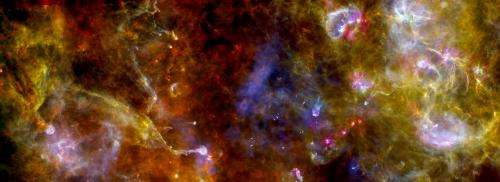All about dust

(Phys.org)—The space between stars is not empty—it contains copious amounts of gas and dust. Astronomers estimate that about 5-10% of the total mass of our Milky Way galaxy is contained in the interstellar gas and dust, and about 1% is in the form of tiny dust grains made predominantly of silicates, rather like fine sand. Some grains are also composed of carbon and other elements.
Interstellar dust plays many key roles in astronomy. Dust absorbs visible light, and so determines in large part what astronomers can see in the visible. At the same time, dust emits at infrared wavelengths, and by virtue of this process of absorption and subsequent re-emission of light dust controls much of the energy balance in the interstellar medium. Dust is also essential to the chemistry that takes place in the interstellar medium because it provides gas molecules with a surface on which to react with other molecules. Dust grains themselves contain a large fraction of many important elements in the universe like silicon, carbon, or iron. Not least, at an early stage in the evolution of new stars the dust around them can coagulate into clumps—a step towards the formation of planets.
Warm dust in space—that is, dust heated by ultraviolet from new stars to the relatively "warm" temperatures of 20 to 60 kelvin—has recently become the subject of intense study thanks to the Herschel Space Observatory. This telescope has instruments designed to image this faint, extended material. Modeling the emission precisely, however, has turned out to be a challenge. One issue is that the color of the emitted radiation depends not only on the temperature but also on the dust grains' size, shape and composition. So far most astronomers have tried to fit their observations to best fits using a simple algorithm that minimizes the cumulative difference between the observed and predicted values at all different wavelengths.
CfA astronomers Brandon Kelly and Alyssa Goodman, with four colleagues, have made significant improvements to the technique of determining dust temperatures and properties from infrared observations. Rather than relying on traditional minimization techniques, they simultaneously fit a set of data points and model predictions (using a so-called Bayesian algorithm), and extract a set of most probable dust values. Their new techniques, when applied to Herschel data, obtain some significant results. Rather than the traditional finding that dust temperature is anti-correlated with its properties like size (that is, hot dust grains are smaller), they find the opposite: a weak correlation between temperature and these properties. The new approach is still being applied, with more results expected, but the work seems to promise a more precise and reliable way to measure the properties of dust, a key component of the interstellar medium.
Provided by Harvard-Smithsonian Center for Astrophysics





















